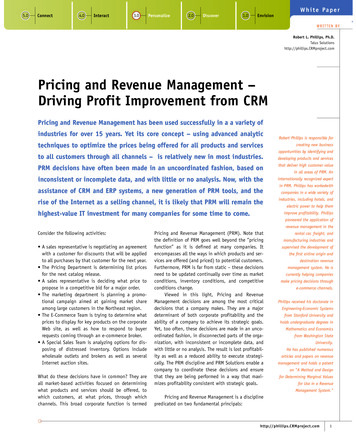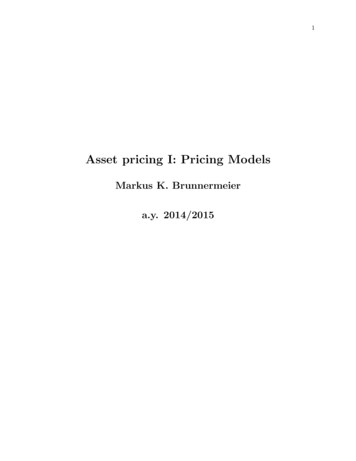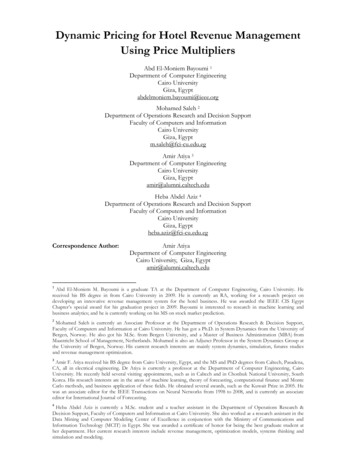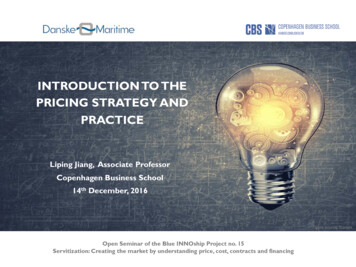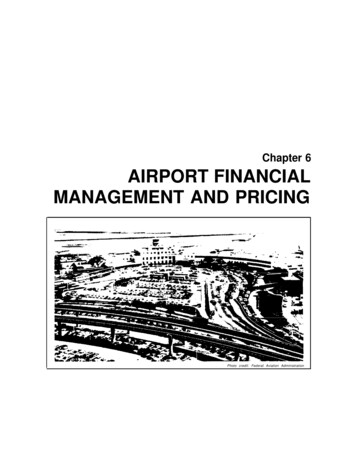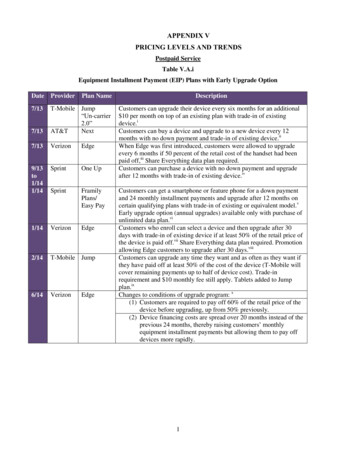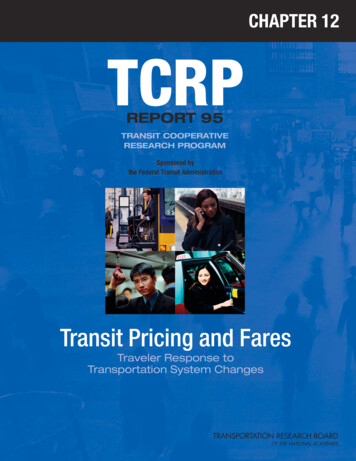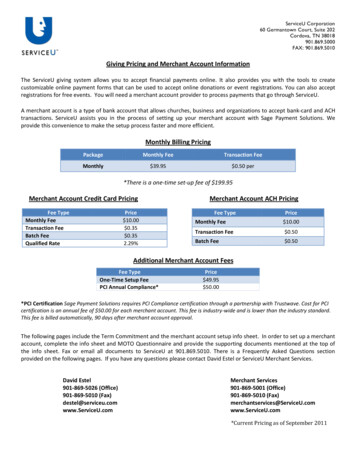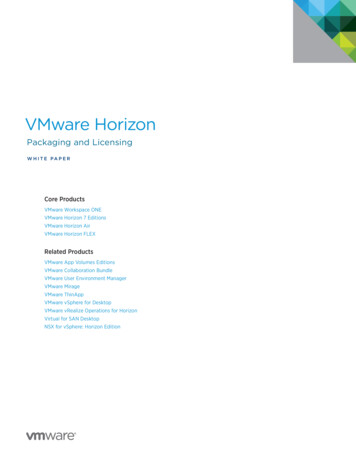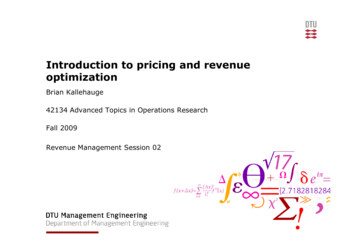
Transcription
Introduction to pricing and revenueoptimizationBrian Kallehauge42134 Advanced Topics in Operations ResearchFall 2009Revenue Management Session 02
Outline Introduction to pricing and revenue optimization– The challenge of pricing– Traditional approaches to pricing– The scope of pricing and revenue optimization– The pricing and revenue optimization process2DTU Management Engineering,Technical University of DenmarkRevenue Management Session 0201/10/2009
Introduction to pricing and revenueoptimization Pricing and revenue optimization is a process for managing and updatingpricing decisions in a consistent and effective way. The goal is to find a set of prices which maximizes total expected profitgiven certain constraints such as business goals and/or limitations of e.g.capacity. Most companies know the list prices for their products but the pricescustomers actually pay for the products are often unclear. Selling prices are influenced by e.g. discounts, adjustments, rebates, etc. There may be big differences between product list prices and pocketprices (actual selling prices). While list prices are generic, pocket prices may vary from customer tocustomer, dependent on which pricer reductions he or she gets.3DTU Management Engineering,Technical University of DenmarkRevenue Management Session 0201/10/2009
Price waterfall (by McKinsey and Company)Price waterfall for a consumer package goods (CPG) company.Source: Mike Reopel of A. T. Kearney.4DTU Management Engineering,Technical University of DenmarkRevenue Management Session 0201/10/2009
Disorganized pricing Each pocket price is rarely the result of a single decision but rater thecumulative result of several decisions – often made by different parts ofthe company without measuring or tracking the individual decisions.– I.e. no specific person or section is in charge of the pricing and noone is responsible for the differentiation in selling prices. Due to disorganized pricing organizations there is a rather low probabilitythat a particular procket price maximizes customer profitability. Even worse: sophisticated and experienced buyers who are aware of theprice waterfall of the selling company quickly learn how to ”divide andconquer” to obtain the largest possible price reductions.– Several buying agents call different parts of the selling company tobargain for extra discounts. Even though very few percent of a company’s goods are sold withoutseveral discounts, the management focuses on the list prices and,therefore, analyze the business and make strategies on a wrong basis.5DTU Management Engineering,Technical University of DenmarkRevenue Management Session 0201/10/2009
Pocket price distribution for a CPG companyOver 50 % gets30 % discountor more26 %19 %16 %9%11 %6%8%2%3%Pocket price distribution for a consumer package goods (CPG) company.Source: Mike Reopel of A. T. Kearney.6DTU Management Engineering,Technical University of DenmarkRevenue Management Session 0201/10/2009
Pricing and revenue optimization Since only 3 % of the buyers pay the list price, this price is not importantto set optimally. Rather, the pricing and revenue optimization (PRO) decision is to set thelist price high and use discounts to target prices to individual customers. The wide pocket price distribution does not tell anything about the qualityof the pricing decisions – sophisticated PRO may very well result in awide price distribution.The important thing is to control the pocket prices in a concious waybased on sound analysis rather than letting the price distribution be aresult of an arbitrary process. The quality of the PRO decisions is measured by the extent to which thepocket prices correlate with customer characteristics which indicate pricesensitivity, i.e. higher discounts to larger, more price sensitive,customers.7DTU Management Engineering,Technical University of DenmarkRevenue Management Session 0201/10/2009
Correlation of discount with customer sizeDiscount levelsas a function ofcustomer sizeis expected.Actual correlationof discount withcustomer sizeabout 0.09 –statisticallyindistinguishablefrom random.Correlation of discount with customer size for a CPG company.Source: Mike Reopel of A. T. Kearney.8DTU Management Engineering,Technical University of DenmarkRevenue Management Session 0201/10/2009
Traditional approaches to pricing Pricing and revenue optimization (PRO) is applied to determine pricesthat maximizes the expected net contribution, incorporating:– costs,– the competitive environment , and– customer demand (or willingness to pay). Cost-plus pricing calculates prices based on costs plus a standard margin. Market-based pricing determines prices based on competitors’ actions. Value-based pricing sets prices based on estimates of how customersvalue the product.9DTU Management Engineering,Technical University of DenmarkRevenue Management Session 0201/10/2009
Cost-plus pricing Cost-plus pricing is preferred by Finance departments since it guaranteesthat each sale produces an adequate profit margin. Cost-plus pricing is perhaps the oldest approach to price control and stillone of the most popular.The technique is very simple: determine the cost of the product and adda certain percentage to determine the price. The surchage often reflects a fixed cost plus a required return on capital.E.g. in the restaurant industry:– food is marked up three times,– beer is marked up four times, and– liquor is marked up six times. Cost-plus pricing seems very appropriate as the company is guaranteedto gain the profit margin if all competitors have similar cost structures.10DTU Management Engineering,Technical University of DenmarkRevenue Management Session 0201/10/2009
Disadvantages of cost-plus pricing The major drawback of cost-plus pricing is the complete ignoration of themarket. Customers’ willingness to pay is not considered when calculating pricesand all buyers are charged the same price.– Recall that setting different prices for different customer segments isthe core of pricing and revenue optimization (PRO). Furthermore, the assumption that the cost prices can be retrieved rarelyholds, i.e. the selling prices are calculated based on a very weakfoundation and only on historical data, not forecasts of future productcosts. In spite of its obvious disadvantages, cost-plus pricing is still very widelyused, perhaps due it the simplicity of the approach.11DTU Management Engineering,Technical University of DenmarkRevenue Management Session 0201/10/2009
Market-based pricing Market-based pricing is preferred by Sales departments since it helpsthem sell against competition.The approach bases prices solely on the prices being offered bycompeting companies.– Market-based pricing is often applied by smaller players in situationswhere there is a clear market leader to compare prices to.– There is no alternative to market-based pricing in markets wherecompetitors sell completely identical products, and where transactionprices are transparent and known by the buyers.– Upcoming low-cost suppliers may also apply market-based pricing inorder to enter a new market by ensuring lower prices than thecurrent players. Though being very approapriate in the above situations, market-basedpricing does not capitalize on customers who value the company’sproducts or brand and does not make use of price differentation.12DTU Management Engineering,Technical University of DenmarkRevenue Management Session 0201/10/2009
Value-based pricing Value-based pricing is preferred by Marketing departments since theyfocus on customer behaviour and how customers value a product.The approach focuses on customer value as the key driver of the price. Historically, value-based pricing usually referred to the use ofmethodologies such as customer surveys, focus groups, and conjointanalysis to estimate how customers value a product relative to thealternatives – which is then used to determine price.– This type of value-based pricing is frequently employed whenintroducing new products in a market. Value-based pricing is a very suitable and promising approach if:– the company is a monopoly,– customer values of the products can actually be determined,– customers are willing to pay the calculated price, and– there is no threat of regulation, cannibalization, etc.13DTU Management Engineering,Technical University of DenmarkRevenue Management Session 0201/10/2009
Disadvantages of value-based pricing Essentially, value-based pricing is impossible!– Determining each individual customer’s value for a product at thepoint of sale is not possible to do.– There is a constant possibiliy of cannibalization, arbitrage, etc.– Competitive pressure means that companies almost always have toprice lower that they would like to any group of customers. The main drawback of value-based pricing is that the approach ignorescompetition.– There is a great difference between the value that a potential buyermight place on a product in isolation and what the customer isactually willing to pay in the market.– A customer may value the product highly but he or she hasalternatives.14DTU Management Engineering,Technical University of DenmarkRevenue Management Session 0201/10/2009
Pricing in practice Cost-plus pricing, market-based pricing, and value-based pricing arepuristic approaches, each focusing narrowly on one or a few parametersand leaving out others. In practice, companies apply combinations of different pricing approachesand modify their pricing strategies from time to time to achieve differentgoals. Applying different approaches rather than being strictly devoted to onespecific pricing method is better for the company.– For example letting Marketing use value-based pricing whenintroducing a new product, letting Sales apply market-based pricingwhen seeking to increase the market share, etc.15DTU Management Engineering,Technical University of DenmarkRevenue Management Session 0201/10/2009
Pricing and revenue optimization Pricing and revenue optimization (PRO) provides a consistent approach topricing decisions across the organization. This means that a company needs to have a clear view of all the prices itis setting in the marketplace and the ways in which those prices are set. The goal of PRO is to provide the right price,– for every product,– to every customer segment,– through every channel,and to update those prices over time in response to changing marketconditions. Each combination of these three dimensions – product, customer type,and channel – has an associated price. For example:– turbines sold to large customers in the north via direct sales channel,– replacement gears sold to small companies via online sales.16DTU Management Engineering,Technical University of DenmarkRevenue Management Session 0201/10/2009
Dimensions of the pricing and revenueoptimization cube In theory, each cell withinthe PRO cube couldcorrespond to a differentprice. In practice, somecombinations of product,channel, and customertype is not meaningful.Dimensions of the PRO cube.17DTU Management Engineering,Technical University of Denmark Furthermore, our abilityto charge different pricesthrough different channelsmay be constrained bypractical considerations orby strategic goals.Revenue Management Session 0201/10/2009
The pricing and revenue optimization cube inpractice The PRO cupe is a useful starting point for a company seeking tounderstand the magnitude of the pricing challenge that it faces. Enumerating the combinations of products, market segments, andchannels gives a rough estimate of the total number of prices a companyneeds to manage. In practice, a successful PRO process includes such an overview of thedifferent prices associated with the different product-market-channelcombinations but also strategic goals such as e.g. charging smallcustomers a lower price in online sales to encourage these to purchaseonline rather than through direct sales.18DTU Management Engineering,Technical University of DenmarkRevenue Management Session 0201/10/2009
Customer commitments A core concept in PRO is the idea of customer commitment, occurring whena seller agrees to provide a customer with products or services, now or inthe future, at a price. The elements of a customer commitment are:– the products and services being offered,– the price,– the time period over which the commitment will be delivered,– the time for which the offered commitment is valid (how long thecustomer has to make up his/her mind),– other element of the contract or transaction (e.g. payment terms orreturn policy),– firmness of the commitment and risk sharing. The forms and types of commitments that sellers make (and buyers expect)vary from industry to industry.– E.g. airline tickets are often refundable whereas theater tickets are not.19DTU Management Engineering,Technical University of DenmarkRevenue Management Session 0201/10/2009
The pricing and revenue optimizationprocess Successful pricing and revenue optimization (PRO) involves twocomponents:1. A consistent business process focused on pricing as a critical set ofdecisions.2. The software and analytical capabilities required to support theprocess. There has been a focus on mathematical analysis in PRO but in order toprovide sustainable improvements, quantitative analysis needs to beembedded in the right process, including eight activities:– Four activities are part of operational PRO. These are executed everytime the company needs to change prices.– Four activities are part of supporting PRO. These occur at longerintervals. PRO is a closed-loop process, i.e. feedback from the market must beincorporated into both the operational activities and the more periodicactivity of updating market response curves.20DTU Management Engineering,Technical University of DenmarkRevenue Management Session 0201/10/2009
The pricing and revenue optimizationprocessThe close
Pricing and revenue optimization is a process for managing and updating pricing decisions in a consistent and effective way. The goal is to find a set of prices which maximizes total expected profit given certain constraints such as business goals and/or limitations of e.g. capacity. Most companies know the list prices for their products but the prices 3 DTU Management Engineering .
